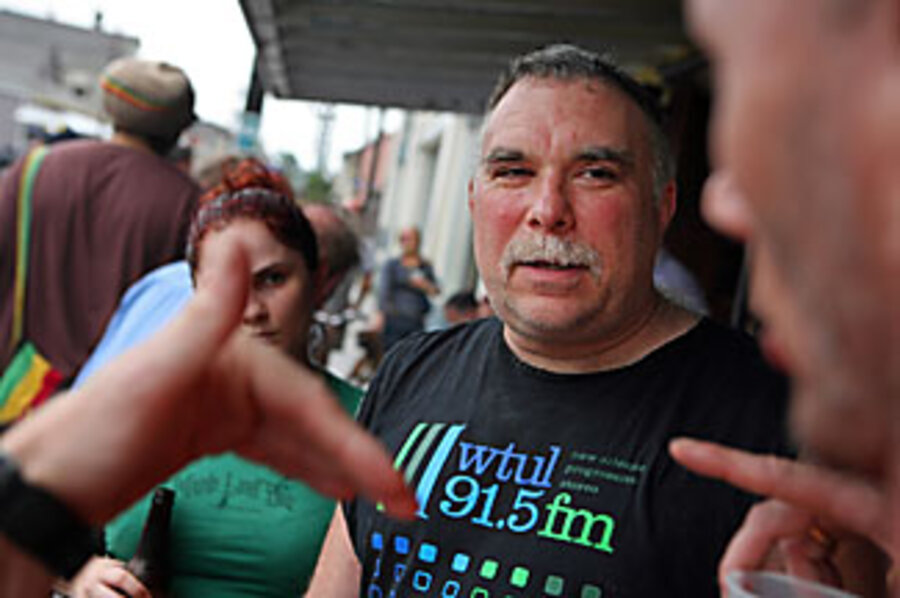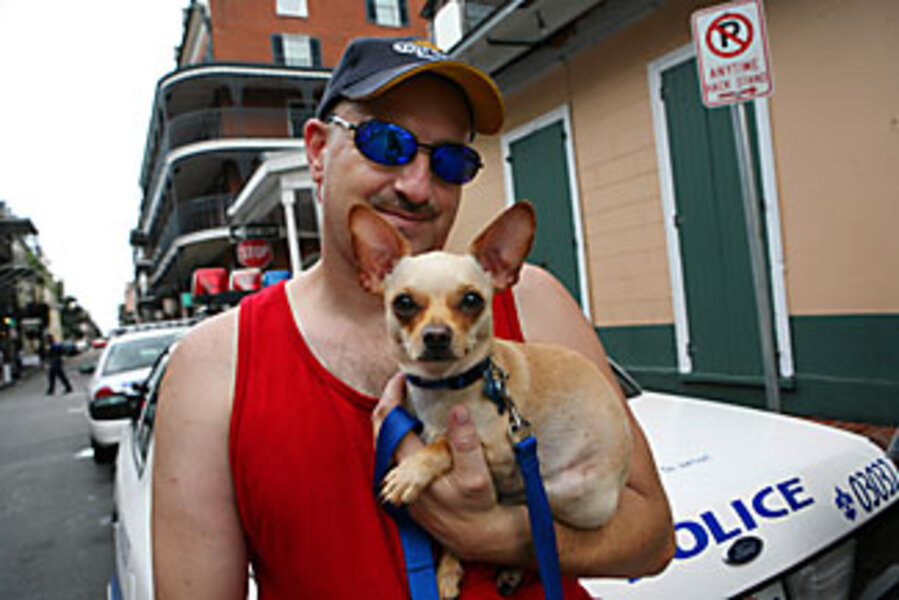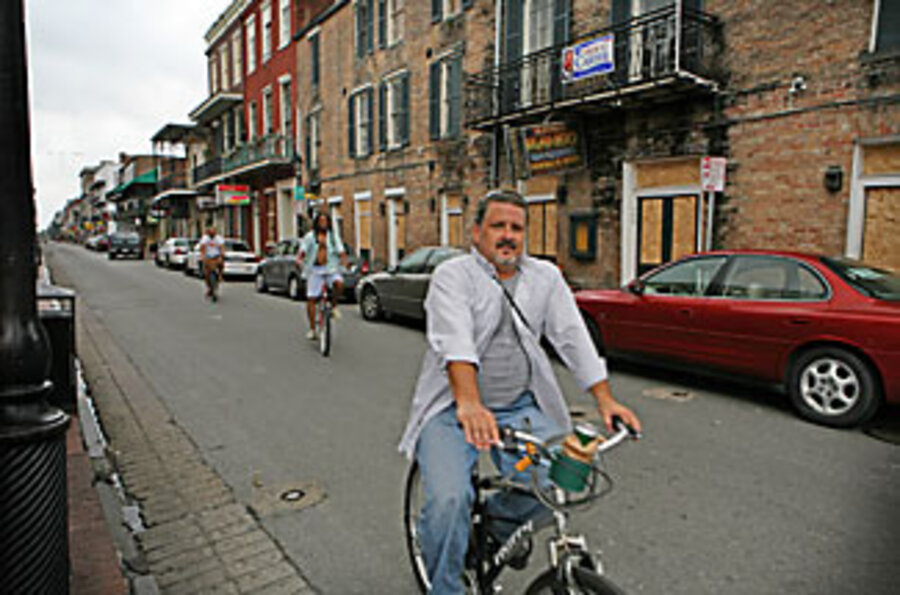Gustav holdouts' tales give evacuees pause
| New Orleans
After curfew on Wednesday night, two National Guard soldiers traded their rifles for a guitar and some drumsticks.
Taking the stage at a tiny lounge in the French Quarter, they plunged into a blues riff that, by the end, became a new song called the "Rockin' Army Blues."
Meanwhile, at a hurricane party in the Uptown neighborhood on the eve of hurricane Gustav's landfall, locals gathered on the front stoop to compare firearms as one young woman cradled a shotgun like she was holding a baby.
The night after Gustav came ashore, small squads of storm holdouts and National Guardsmen played an elaborate game of curfew cat-and-mouse. But they finally gave up as everyone ended up at the Maple Leaf lounge for a late-night gab session.
As Mayor Ray Nagin lifted checkpoints a day early Wednesday to allow residents to return, the few thousand New Orleanians who stayed put for Gustav will regale some quarter-million returning evacuees with such mirthful, and true, storm stories, often in sharp contrast to tales of evacuation frustration from a weather event described in the aftermath as little more than a prolonged thunderstorm.
The role of story-swapping
Indeed, nearly as important as official warnings and news bulletins, front porch story-swapping among storm survivors plays a critical role in how Americans respond to the next looming megastorm. Now, US emergency officials are trying to listen in, increasingly keen to understand a basic, but crucial, concept of storm planning: A good evacuation, like a good story, is all in the details.
"The big truths, universal truths, profound truths about these storms do come out of the kind of day-to-day experiences that people remember and confront," says Louis Kyriakoudes, director of the Center for Oral History and Cultural Heritage at the University of Southern Mississippi in Hattiesburg. "There's a singular and unique value in how people perceive what has happened to them."
While Katrina created thousands of both tragic and heroic stories that have been spun into countless yarns, articles, masters' theses, and books, Gustav's more mundane story lines are now becoming clear: Holdouts hunkered down, emerging to calmly walk their dogs and sweep up after the storm. Evacuees endured 12-hour car rides, shelters without enough cots, and then began running out of supplies and money as law enforcement kept them from returning.
To be sure, the decision on whether or not to evacuate again depends on more than perceptions and observations of hardship. In fact, researchers say, the two camps – the stayers and the leavers – tend to stick to their methods. Since Katrina, both federal and state officials have tried to wear down the resolve of those who historically stay, tapping into the gruesome memories from Katrina to drive home the message. This time, it appeared to have worked as the Gustav evacuation became the largest in US history, with over 2 million people leaving the Gulf Coast starting three days before the storm hit.
"An adventure is just misfortune properly reconsidered," says Michael Lindell, director of the Hazard Reducation and Recovery Center in College Station, Texas. "It's not a very large proportion of evacuees, even if the hurricane fails to strike their community, that will say, 'I won't go next time.' Most people are influenced consistently by conditions."
Yet it was precisely the US government's disinterest in the anecdotal wisdom of veteran regional Federal Emergency Management Agency (FEMA) managers that led to the fiasco of Katrina, says Mr. Lindell. In fact, one reason for the myriad mishaps and blunders that characterized the Katrina evacuation, rescue, and recovery had to do with a philosophical shift in the Bush administration, where political appointees at the bureaucratic level had little use for anecdotal wisdom and survivor surveys that have historically informed regional FEMA managers.
Now, FEMA and state emergency response agencies are beginning to pay closer attention again to taxpayer-funded research, including $150,000 worth of studies done by Texas A&M University and a comprehensive oral history project at the University of Southern Mississippi, that tries to gauge the anecdotal experiences of evacuees and how those stories affect future decisions.
"People think about these types of things," says Lindell. "Some will come back and say they spent miserable nights leaving and trying to come back while other people stayed home and had a party. Some of those people will definitely say, 'I'm not going to make that mistake again of leaving.'"
The need to share the lessons
To many storm survivors, stories – whether the drama-heavy warnings of Mayor Nagin or the recollections of makeshift militias patrolling New Orleans after Katrina – supply a human need to share information, lessons, tragedy, and wonderment, all of which, to some, reaffirm how people have confronted storms through generations.
Bartender Travis Phelps, for example, says he emerged after the worst of Gustav, walked to the Mississippi River levee, and stood atop it in wonder. "It was like that movie 'I Am Legend,'" he says. "It felt like I was alone in the world."
Juan Parke, a lanky, lifelong New Orleanian, became part of a makeshift militia after hurricane Katrina, based at the boarded-up Maple Leaf lounge. Parke's son, Deen, was too young to stay for Katrina, but, now 13, he insisted on staying with his father for Gustav. At the high point of the storm Monday morning, inspired by his father's tales, Deen stepped out into the street to lean against the lashing winds.
"We're storytelling creatures," says Parke. "This goes back to the Iliad, with one guy telling another guy a really interesting story about what happened to him."
But for all the blustery storm stories told on the stoop of the Maple Leaf, the stories that sometimes don't get told are about the primal dread that hangers-on fight back and don't always talk about, says Hank Staples, owner of the tavern.
The Maple Leaf served as a kind of armory during Katrina, including "swap tables" of emergency goods, which law enforcement officials appreciated. Yet there was a palpable tension this time, Mr. Staples says, as authorities worried that the stories of hangers-on threatened to undermine the official evacuation rhetoric.
"On the one hand, [law enforcement] appreciates what we're doing," says Staples. "On the other hand, they're worried we create the impression to those returning to the city that these storms are harmless."







